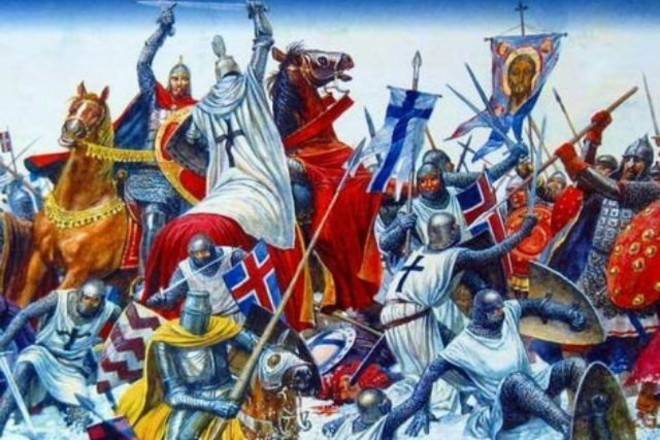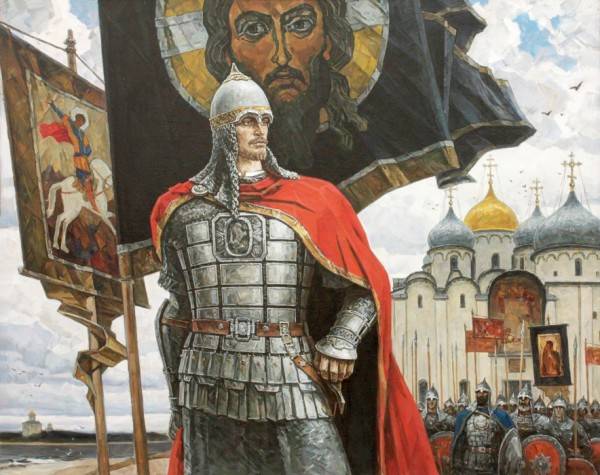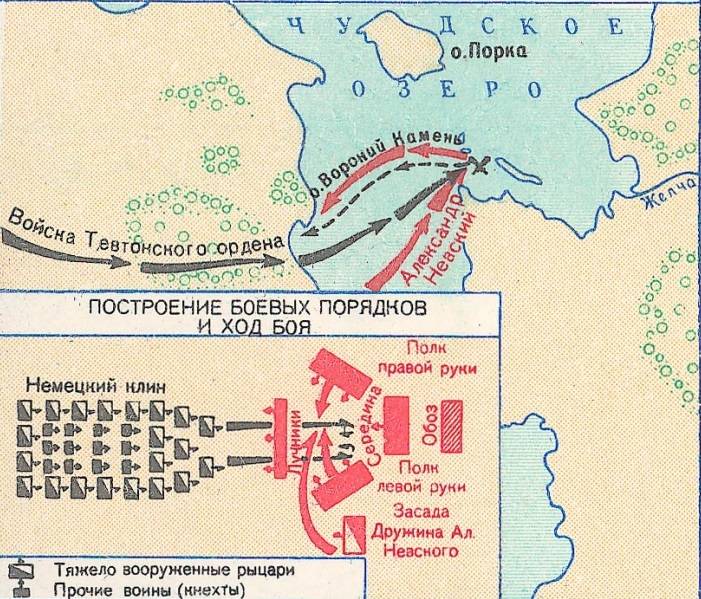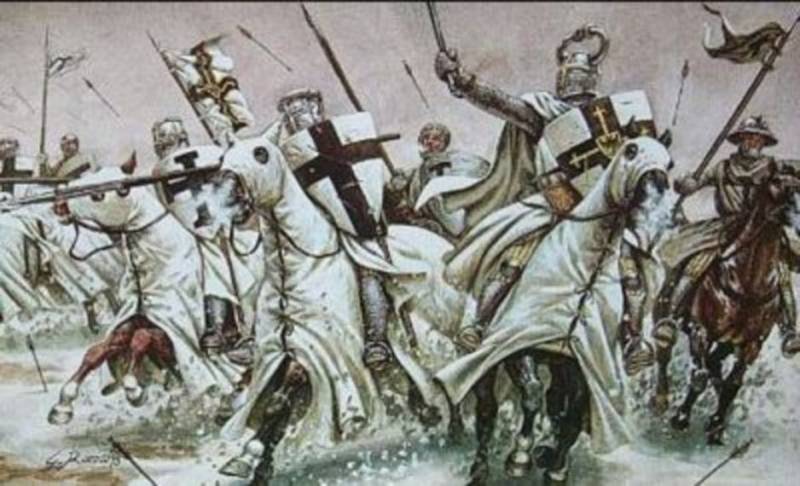Battle of the Ice: the great battle of Russia against the West
Interestingly, in the same 1990-ies, Russian political parties of a nationalistic nature, with the suggestion of notorious followers of the writer Eduard Limonov, began to celebrate April 5 on the Day of the Russian Nation, also dedicated to the victory on Lake Peipsi. The difference in dates was due to the fact that the “Limonovtsy” chose to mark the date of April 5 on the Julian calendar, and the official memorable date is considered according to the Gregorian calendar. But the most interesting thing is that, according to the Proleptic Gregorian calendar, which extends to the period before 1582, this date should be celebrated on April 12. But in any case, the very decision itself was to appoint a date to commemorate such a large-scale event in the national stories. Moreover, it was one of the first and most impressive episodes of the clash between the Russian world and the West. Subsequently, Russia will more than once fight with Western countries, but the memory of the soldiers of Alexander Nevsky, who defeated the German knights, is still alive.

The events that will be discussed below unfolded against the background of the total weakening of the Russian principalities during the Mongol invasion. In 1237-1240 the Mongol hordes again invaded Russia. This time was prudently used by Pope Gregory IX for another expansion to the northeast. Then Holy Rome prepared, firstly, a crusade against Finland, at that time still inhabited mainly by pagans, and secondly - against Russia, which was considered by the pontiff as the main competitor of Catholics in the Baltic States.
The Teutonic Order was ideally suited for the role of expansionist intentions. The times, which will be discussed, were the heyday of the Order of heyday. Later, during the Livonian War of Ivan the Terrible, the order was in far from the best condition, and then, in the XIII century, the young military-religious formation was a very strong and aggressive opponent who controlled the imposing territories on the shores of the Baltic Sea. The Order was considered the main conduit for the influence of the Catholic Church in Northeastern Europe and sent its blows against the Baltic and Slavic peoples living in these parts. The main task of the order was the enslavement and conversion of local residents to Catholicism, and if they did not want to accept the Catholic faith, the "noble knights" mercilessly destroyed the "pagans". The Teutonic knights appeared in Poland, called upon the Polish prince to help in the struggle against the Prussian tribes. The conquest of the Prussian lands began, which took place quite actively and rapidly.
It should be noted that the official residence of the Teutonic Order during the described events was still in the Middle East - in the castle of Monfor in the territory of modern Israel (the historical land of Upper Galilee). The Grand Master of the Teutonic Order, the archive and the treasury were housed in Monfort. Thus, top management managed the order possessions in the Baltics remotely. In 1234, the Teutonic Order swallowed up the remnants of the Dobrin Order, created in 1222 or 1228 in Prussia to protect the Prussian episcopacy from attacks by Prussian tribes.
When, in 1237, the remnants of the Order of the Sword (Brotherhood of the Soldiers of Christ) joined the Teutonic Order, the Teutonic people gained control over the possessions of the Sword in Livonia. On the Livonian lands of the Swordsmen, the Livonian Landmaister of the Teutonic Order arose. Interestingly, the emperor of the Holy Roman Empire, Frederick II, still in 1224, declared the lands of Prussia and Livonia to be directly subordinate to Holy Rome, and not to the local authorities. The Order became the chief vicar of the papal throne and the spokesman for the papal will in the Baltic lands. At the same time, the course continued for the further expansion of the order in Eastern Europe and the Baltic states.
Back in 1238, the Danish king Waldemar II and the Grand Master of the Order Hermann Balk agreed on the division of the land of Estonia. Novgorod the Great was the main obstacle for the German-Danish knights, and it was precisely against him that the main blow was directed. In alliance with the Teutonic Order and Denmark made Sweden. In July, 1240, the Swedish ships appeared on the Neva, but already 15 in July, 1240, on the banks of the Neva, Prince Alexander Yaroslavich inflicted a crushing defeat on the Swedish knights. For this he was nicknamed Alexander Nevsky.
The defeat of the Swedes did not greatly contribute to the failure of their allies from their aggressive plans. The Teutonic Order and Denmark were going to continue the campaign against North-Eastern Russia in order to implant Catholicism. Already at the end of August 1240, the bishop German Dorptsky set off on a campaign against Russia. He gathered an impressive army of the knights of the Teutonic Order, the Danish knights of the Revel fortress and the militia of Dorpat, and invaded the territory of the modern Pskov region.
Resistance Pskov did not give the proper result. Knights seized Izborsk, and then besieged Pskov. Although the first siege of Pskov did not bring the desired result and the knights retreated, they soon returned and were able to take the Pskov fortress, using the help of the former Pskov prince Yaroslav Vladimirovich and the boyars traitors headed by Tverdilo Ivankovich. Pskov was taken, it housed the knightly garrison. Thus, the Pskov land became a springboard for the actions of the German knights against Veliky Novgorod.
A difficult situation at this time evolved in Novgorod itself. Townsmen in winter 1240 / 1241 were driven out of Novgorod by Prince Alexander. Only when the enemy approached the city very close, they sent messengers to Pereslavl-Zalessky to call Alexander. In 1241, the prince marched on Koporye, captured it by storm, interrupting the knightly garrison there. Then, by March, 1242, Alexander, waiting for the help of Prince Andrew's troops from Vladimir, marched on Pskov and soon took the city, forcing the knights to retreat to the Dorpat bishopric. Then Alexander invaded the Order of the Order, but when the advanced forces were defeated by the knights, he decided to step back and prepare in the area of Lake Peipsi for the main battle. The balance of forces of the parties, according to the sources, was approximately 15-17 of thousands of soldiers from Russia, and 10-12 of thousands of Livonian and Danish knights, as well as the militia of the Dorpat bishopric.

The Russian army was commanded by Prince Alexander Nevsky, and the knights by the landmaster of the Teutonic Order in Livonia, Andreas von Felfen. A native of Austrian Styria, Andreas von Felfen was commander (commandant) of Riga before taking the post of deputy governor of the Order in Livonia. The fact that it was for the commander, shows the fact that he decided not to personally participate in the battle on Lake Peipsi, but remained at a safe distance, transferring the command to the younger order commanders. Danish knights were commanded by the sons of King Valdemar II himself.
As is known, the Crusaders of the Teutonic Order usually used as a battle order the so-called “pig” or “boar's head” - a long column, at the head of which was a wedge from the ranks of the most powerful and experienced knights. Forces of squires followed the wedge, and in the center of the column - infantry from mercenaries - immigrants from the Baltic tribes. A heavily armed knightly cavalry followed along the sides of the column. The meaning of such a construction was that the knights wedged into the enemy, splitting it into two parts, then broke into smaller parts, and only then finished off with the participation of their infantry.
Prince Alexander Nevsky undertook a very interesting move - he had previously placed his forces on the flanks. In addition, Alexander and Andrei Yaroslavich’s cavalry brigade housed in ambush. The Novgorod militia fell in the center, and in front was a chain of archers. Behind, they set up chained wagons, which were supposed to deprive the knights of the ability to maneuver and evade attacks of the Russian army. 5 (12) April 1242, the Russians and knights entered combat contact. The archers first took the onslaught of the knights, and then the knights were able to break through the Russian system with the help of their famous wedge. But it was not there - the heavily armed knightly cavalry got stuck in the train, and then the shelves of the right and left hands moved from the flanks to it. Then the prince's squads entered the battle, who turned the knights to flight. The ice broke through, unable to bear the weight of the knights, and the Germans began to sink. The warriors of Alexander Nevsky chased the knights across the ice of Lake Peipsi seven miles away. The Teutonic Order and Denmark suffered a complete defeat in the Battle of Lake Peipsi. According to the Simeon Chronicle, the Germans 800 were killed and the Chudi "without a number", the 50 knights were captured. Loss of troops of Alexander Nevsky unknown.

The defeat of the Teutonic Order had an impressive effect on his leadership. The Teutonic Order abandoned all territorial claims against Novgorod the Great and returned all lands seized not only in Russia, but also in Latgale. Thus, the effect of the defeat inflicted on the German knights was colossal, primarily in the political sense. To the West, the Ice Battle showed that in Russia, glorious crusaders are waiting for a strong opponent, ready to fight to their homeland to the last. Later, Western historians tried in every way to downplay the significance of the battle on Lake Peipsi — they argued that in fact there were much smaller forces there, then they described the battle as the starting point for the formation of the “myth of Alexander Nevsky”.
The victories of Alexander Nevsky over the Swedes and over the Teutonic and Danish knights had a large-scale significance for further Russian history. Who knows how the history of the Russian land would have been, if the soldiers of Alexander had not won these battles then. After all, the main goal of the knights was the conversion of the Russian lands to Catholicism and the complete subordination to the sovereignty of the order, and through it to Rome. For Russia, therefore, the battle was of decisive importance in terms of preserving national and cultural identity. We can say that the Russian world was forged, including in the battle on Lake Peipsi.
Alexander Nevsky, who defeated the Swedes and Teutons, forever entered Russian history both as a church saint and as a brilliant military leader and defender of the Russian land. It is clear that no less was the contribution and countless warriors of Novgorod and princely warriors. Their history has not kept their names, but for us, who lived 776 years later, Alexander Nevsky - this is, in particular, those Russian people who fought on Lake Peipsi. He became the personification of the Russian military spirit, power. It was during his time that Russia showed the West that she was not going to obey him, that she was a special land with her own way of life, with her people, with her own cultural code. Then the Russian soldiers had to "give too much time" to the West more than once. But the starting point was the battle won by Alexander Nevsky.
Followers of political Eurasianism say that Alexander Nevsky predetermined the Eurasian choice of Russia. During his reign, Rus developed more peaceful relations with the Mongols than with the German knights. At least, the Mongols did not seek to destroy the identity of the Russian people, imposing their beliefs on them. In any case, the political wisdom of the prince was that in difficult times for the Russian land, he was able to relatively secure Novgorod Russia in the east, winning battles in the west. That was his military and diplomatic talents.
776 years have passed, but the memory of the feat of the Russian soldiers in the battle on Lake Peipsi is preserved. In 2000-s, a number of monuments to Alexander Nevsky were opened in Russia - in St. Petersburg, Veliky Novgorod, Petrozavodsk, Kursk, Volgograd, Aleksandrov, Kaliningrad and many other cities. Eternal memory to the prince and to all Russian soldiers who defended their land in that battle.

Information